Marketing Principles Report: Analysis of British SME Marketing
VerifiedAdded on 2020/01/07
|22
|5364
|180
Report
AI Summary
This report provides a comprehensive analysis of marketing principles, focusing on their application to a British SME and a case study of Tesco. The report begins with an introduction to marketing principles, including pricing, promotion, and distribution. Task 1 delves into the various elements of the marketing process for British SMEs, examining situational analysis, marketing strategy, designing marketing tactics, and implementation and control. It also explores marketing orientation, cost benefits, and the influence of macro and micro environmental factors. Furthermore, the report contrasts international and domestic marketing, and discusses product development and distribution strategies. Task 2 analyzes segmentation, targeting, and positioning criteria for Tesco, and plans marketing mixes for different segments. The report covers buyer behavior and the differences in marketing products and services to businesses versus consumers. The report highlights how British SME can use marketing to gain competitive advantage and customer satisfaction. The report concludes with a discussion on the key findings and implications of the analysis.

MARKETING PRINCIPLES
Paraphrase This Document
Need a fresh take? Get an instant paraphrase of this document with our AI Paraphraser
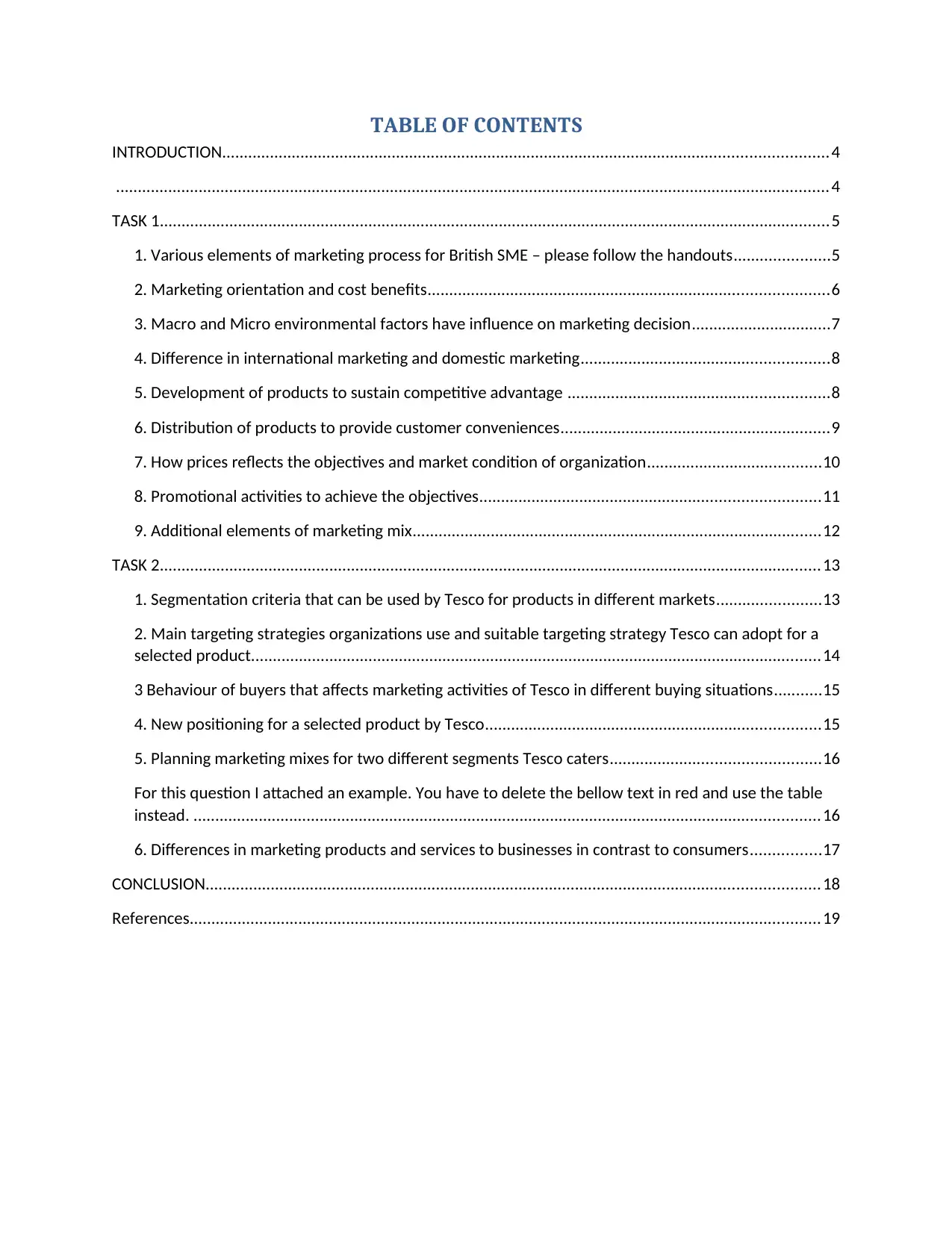
TABLE OF CONTENTS
INTRODUCTION...........................................................................................................................................4
....................................................................................................................................................................4
TASK 1..........................................................................................................................................................5
1. Various elements of marketing process for British SME – please follow the handouts......................5
2. Marketing orientation and cost benefits............................................................................................6
3. Macro and Micro environmental factors have influence on marketing decision................................7
4. Difference in international marketing and domestic marketing.........................................................8
5. Development of products to sustain competitive advantage ............................................................8
6. Distribution of products to provide customer conveniences..............................................................9
7. How prices reflects the objectives and market condition of organization........................................10
8. Promotional activities to achieve the objectives..............................................................................11
9. Additional elements of marketing mix..............................................................................................12
TASK 2........................................................................................................................................................13
1. Segmentation criteria that can be used by Tesco for products in different markets........................13
2. Main targeting strategies organizations use and suitable targeting strategy Tesco can adopt for a
selected product...................................................................................................................................14
3 Behaviour of buyers that affects marketing activities of Tesco in different buying situations...........15
4. New positioning for a selected product by Tesco.............................................................................15
5. Planning marketing mixes for two different segments Tesco caters................................................16
For this question I attached an example. You have to delete the bellow text in red and use the table
instead. ................................................................................................................................................16
6. Differences in marketing products and services to businesses in contrast to consumers................17
CONCLUSION.............................................................................................................................................18
References.................................................................................................................................................19
INTRODUCTION...........................................................................................................................................4
....................................................................................................................................................................4
TASK 1..........................................................................................................................................................5
1. Various elements of marketing process for British SME – please follow the handouts......................5
2. Marketing orientation and cost benefits............................................................................................6
3. Macro and Micro environmental factors have influence on marketing decision................................7
4. Difference in international marketing and domestic marketing.........................................................8
5. Development of products to sustain competitive advantage ............................................................8
6. Distribution of products to provide customer conveniences..............................................................9
7. How prices reflects the objectives and market condition of organization........................................10
8. Promotional activities to achieve the objectives..............................................................................11
9. Additional elements of marketing mix..............................................................................................12
TASK 2........................................................................................................................................................13
1. Segmentation criteria that can be used by Tesco for products in different markets........................13
2. Main targeting strategies organizations use and suitable targeting strategy Tesco can adopt for a
selected product...................................................................................................................................14
3 Behaviour of buyers that affects marketing activities of Tesco in different buying situations...........15
4. New positioning for a selected product by Tesco.............................................................................15
5. Planning marketing mixes for two different segments Tesco caters................................................16
For this question I attached an example. You have to delete the bellow text in red and use the table
instead. ................................................................................................................................................16
6. Differences in marketing products and services to businesses in contrast to consumers................17
CONCLUSION.............................................................................................................................................18
References.................................................................................................................................................19

LIST OF TABLES
⊘ This is a preview!⊘
Do you want full access?
Subscribe today to unlock all pages.

Trusted by 1+ million students worldwide
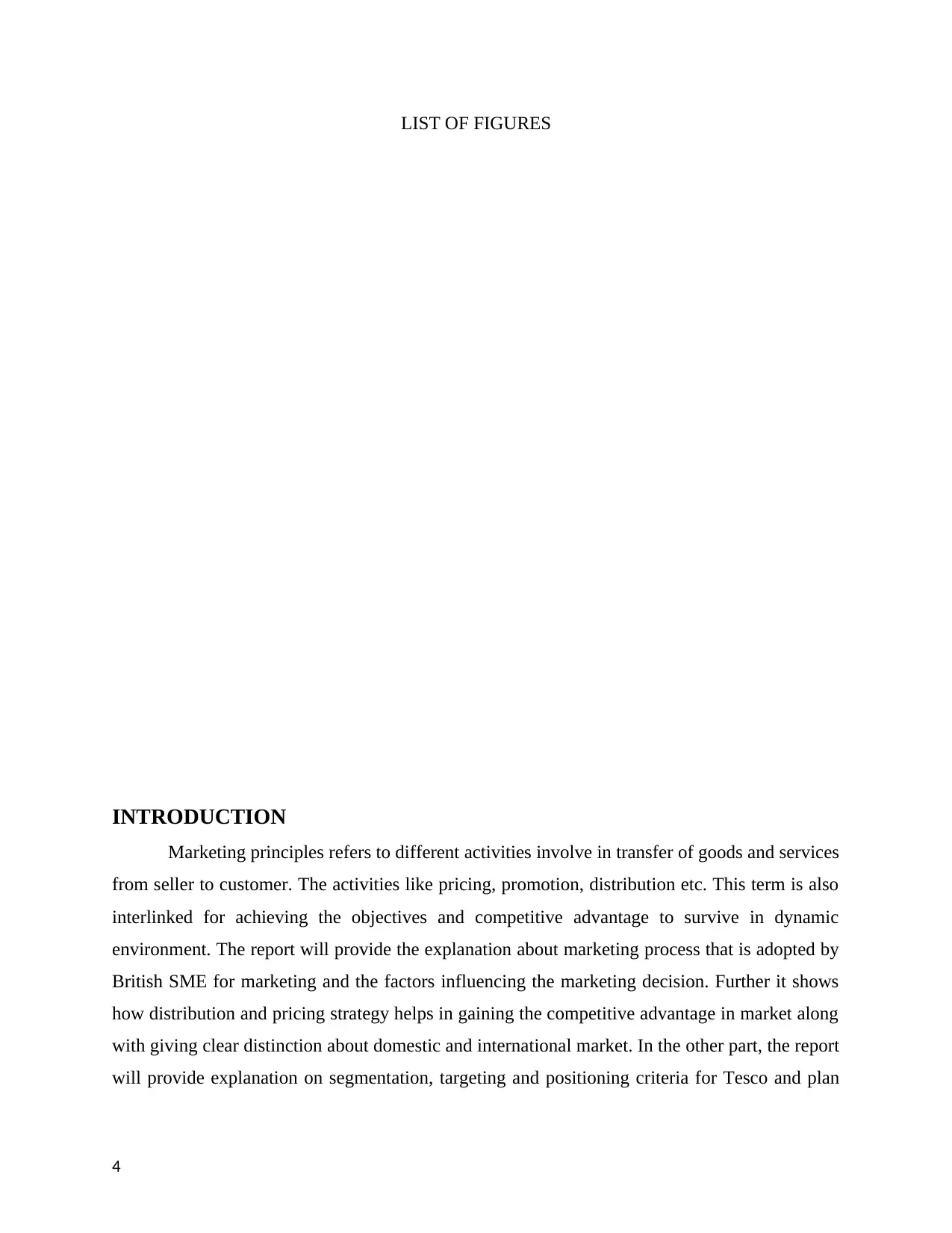
LIST OF FIGURES
INTRODUCTION
Marketing principles refers to different activities involve in transfer of goods and services
from seller to customer. The activities like pricing, promotion, distribution etc. This term is also
interlinked for achieving the objectives and competitive advantage to survive in dynamic
environment. The report will provide the explanation about marketing process that is adopted by
British SME for marketing and the factors influencing the marketing decision. Further it shows
how distribution and pricing strategy helps in gaining the competitive advantage in market along
with giving clear distinction about domestic and international market. In the other part, the report
will provide explanation on segmentation, targeting and positioning criteria for Tesco and plan
4
INTRODUCTION
Marketing principles refers to different activities involve in transfer of goods and services
from seller to customer. The activities like pricing, promotion, distribution etc. This term is also
interlinked for achieving the objectives and competitive advantage to survive in dynamic
environment. The report will provide the explanation about marketing process that is adopted by
British SME for marketing and the factors influencing the marketing decision. Further it shows
how distribution and pricing strategy helps in gaining the competitive advantage in market along
with giving clear distinction about domestic and international market. In the other part, the report
will provide explanation on segmentation, targeting and positioning criteria for Tesco and plan
4
Paraphrase This Document
Need a fresh take? Get an instant paraphrase of this document with our AI Paraphraser

the marketing mix of two different segments in the current case. Tesco profits have grown in just
13 years by more than four and a half time and it is the largest retail supermarket stores and
grocery department itself have 30.5 percent share that is incredible for the success of the Tesco.
TASK 1
1.1 Various elements of marketing process for British SME
Marketing is the wide platform to interact with consumer and to offer variety of their
products and services. It is the process to achieve the desired goals and objectives with assigning
right work to right employee at the right time and to provide the product at reasonable price to
achieve the competitive advantages. The following are the key elements of marketing process
which can be used by British SME:
Illustration 1: Marketing process
Situational analysis- This is important element of marketing process that helps to gain the
knowledge about the market conditions and organizational capabilities. By conducting the
situational analysis, organization will able to develop the marketing plan more professional
manners and achieve their objectives by working on the issues.
5
13 years by more than four and a half time and it is the largest retail supermarket stores and
grocery department itself have 30.5 percent share that is incredible for the success of the Tesco.
TASK 1
1.1 Various elements of marketing process for British SME
Marketing is the wide platform to interact with consumer and to offer variety of their
products and services. It is the process to achieve the desired goals and objectives with assigning
right work to right employee at the right time and to provide the product at reasonable price to
achieve the competitive advantages. The following are the key elements of marketing process
which can be used by British SME:
Illustration 1: Marketing process
Situational analysis- This is important element of marketing process that helps to gain the
knowledge about the market conditions and organizational capabilities. By conducting the
situational analysis, organization will able to develop the marketing plan more professional
manners and achieve their objectives by working on the issues.
5
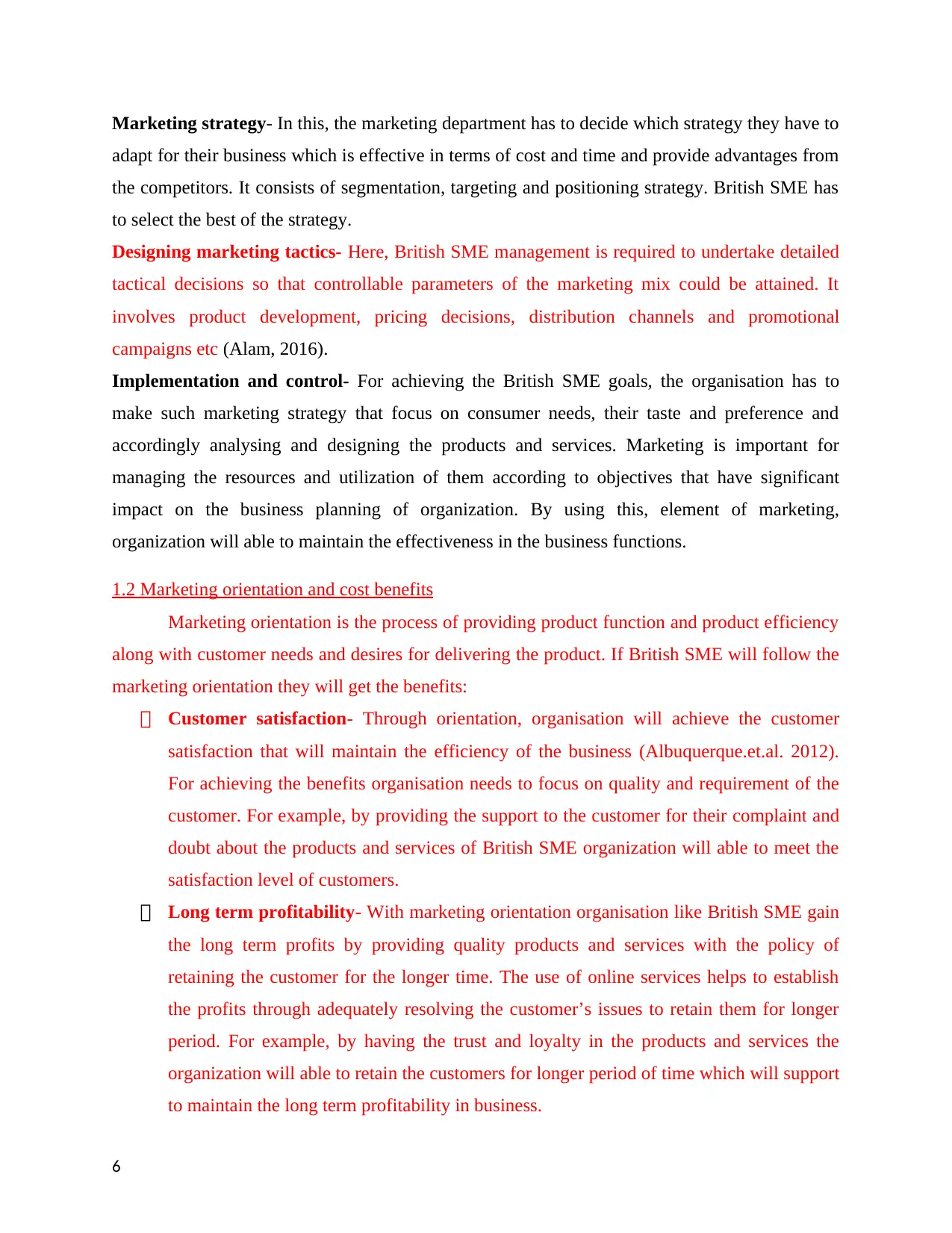
Marketing strategy- In this, the marketing department has to decide which strategy they have to
adapt for their business which is effective in terms of cost and time and provide advantages from
the competitors. It consists of segmentation, targeting and positioning strategy. British SME has
to select the best of the strategy.
Designing marketing tactics- Here, British SME management is required to undertake detailed
tactical decisions so that controllable parameters of the marketing mix could be attained. It
involves product development, pricing decisions, distribution channels and promotional
campaigns etc (Alam, 2016).
Implementation and control- For achieving the British SME goals, the organisation has to
make such marketing strategy that focus on consumer needs, their taste and preference and
accordingly analysing and designing the products and services. Marketing is important for
managing the resources and utilization of them according to objectives that have significant
impact on the business planning of organization. By using this, element of marketing,
organization will able to maintain the effectiveness in the business functions.
1.2 Marketing orientation and cost benefits
Marketing orientation is the process of providing product function and product efficiency
along with customer needs and desires for delivering the product. If British SME will follow the
marketing orientation they will get the benefits:
Customer satisfaction- Through orientation, organisation will achieve the customer
satisfaction that will maintain the efficiency of the business (Albuquerque.et.al. 2012).
For achieving the benefits organisation needs to focus on quality and requirement of the
customer. For example, by providing the support to the customer for their complaint and
doubt about the products and services of British SME organization will able to meet the
satisfaction level of customers.
Long term profitability- With marketing orientation organisation like British SME gain
the long term profits by providing quality products and services with the policy of
retaining the customer for the longer time. The use of online services helps to establish
the profits through adequately resolving the customer’s issues to retain them for longer
period. For example, by having the trust and loyalty in the products and services the
organization will able to retain the customers for longer period of time which will support
to maintain the long term profitability in business.
6
adapt for their business which is effective in terms of cost and time and provide advantages from
the competitors. It consists of segmentation, targeting and positioning strategy. British SME has
to select the best of the strategy.
Designing marketing tactics- Here, British SME management is required to undertake detailed
tactical decisions so that controllable parameters of the marketing mix could be attained. It
involves product development, pricing decisions, distribution channels and promotional
campaigns etc (Alam, 2016).
Implementation and control- For achieving the British SME goals, the organisation has to
make such marketing strategy that focus on consumer needs, their taste and preference and
accordingly analysing and designing the products and services. Marketing is important for
managing the resources and utilization of them according to objectives that have significant
impact on the business planning of organization. By using this, element of marketing,
organization will able to maintain the effectiveness in the business functions.
1.2 Marketing orientation and cost benefits
Marketing orientation is the process of providing product function and product efficiency
along with customer needs and desires for delivering the product. If British SME will follow the
marketing orientation they will get the benefits:
Customer satisfaction- Through orientation, organisation will achieve the customer
satisfaction that will maintain the efficiency of the business (Albuquerque.et.al. 2012).
For achieving the benefits organisation needs to focus on quality and requirement of the
customer. For example, by providing the support to the customer for their complaint and
doubt about the products and services of British SME organization will able to meet the
satisfaction level of customers.
Long term profitability- With marketing orientation organisation like British SME gain
the long term profits by providing quality products and services with the policy of
retaining the customer for the longer time. The use of online services helps to establish
the profits through adequately resolving the customer’s issues to retain them for longer
period. For example, by having the trust and loyalty in the products and services the
organization will able to retain the customers for longer period of time which will support
to maintain the long term profitability in business.
6
⊘ This is a preview!⊘
Do you want full access?
Subscribe today to unlock all pages.

Trusted by 1+ million students worldwide
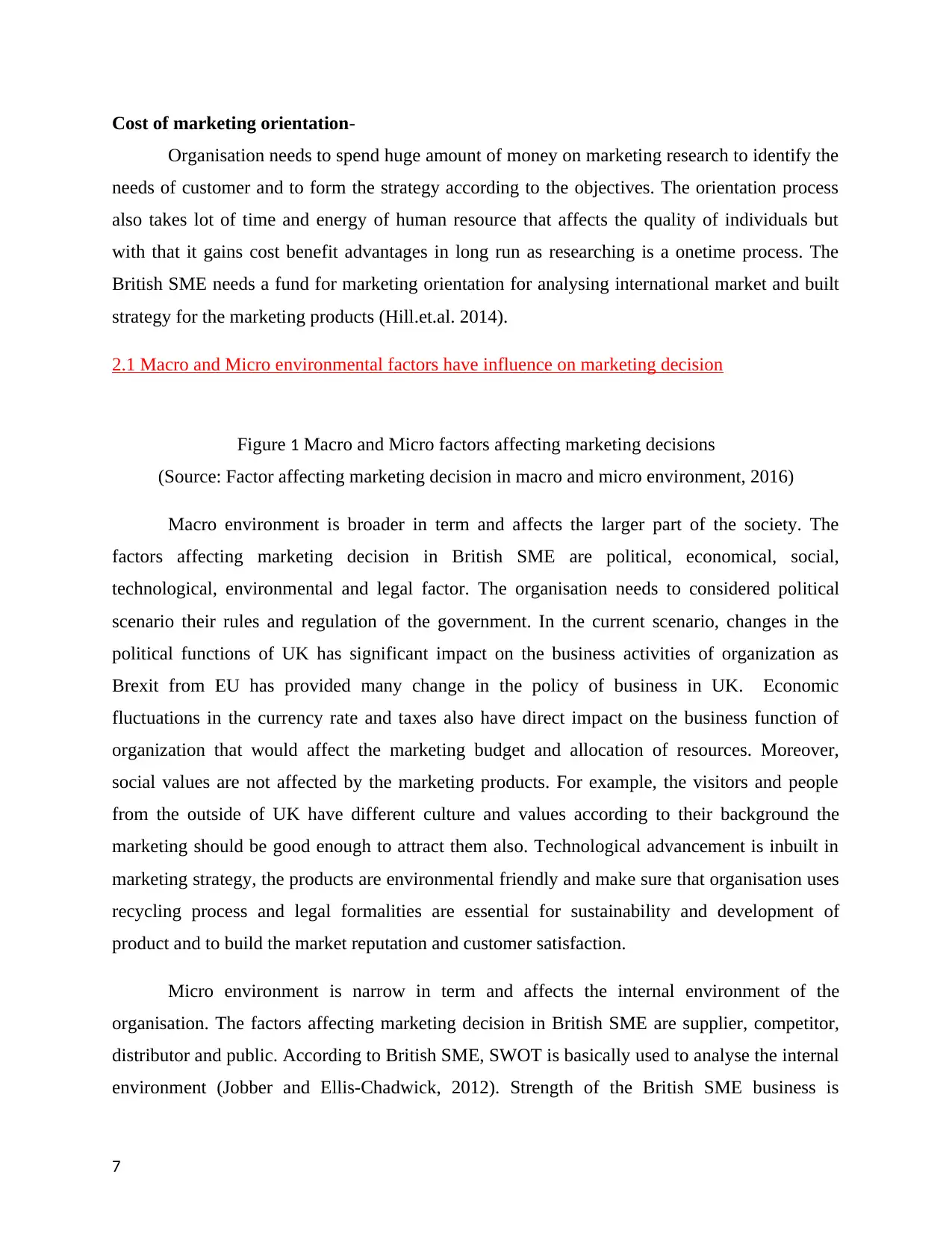
Cost of marketing orientation-
Organisation needs to spend huge amount of money on marketing research to identify the
needs of customer and to form the strategy according to the objectives. The orientation process
also takes lot of time and energy of human resource that affects the quality of individuals but
with that it gains cost benefit advantages in long run as researching is a onetime process. The
British SME needs a fund for marketing orientation for analysing international market and built
strategy for the marketing products (Hill.et.al. 2014).
2.1 Macro and Micro environmental factors have influence on marketing decision
Figure 1 Macro and Micro factors affecting marketing decisions
(Source: Factor affecting marketing decision in macro and micro environment, 2016)
Macro environment is broader in term and affects the larger part of the society. The
factors affecting marketing decision in British SME are political, economical, social,
technological, environmental and legal factor. The organisation needs to considered political
scenario their rules and regulation of the government. In the current scenario, changes in the
political functions of UK has significant impact on the business activities of organization as
Brexit from EU has provided many change in the policy of business in UK. Economic
fluctuations in the currency rate and taxes also have direct impact on the business function of
organization that would affect the marketing budget and allocation of resources. Moreover,
social values are not affected by the marketing products. For example, the visitors and people
from the outside of UK have different culture and values according to their background the
marketing should be good enough to attract them also. Technological advancement is inbuilt in
marketing strategy, the products are environmental friendly and make sure that organisation uses
recycling process and legal formalities are essential for sustainability and development of
product and to build the market reputation and customer satisfaction.
Micro environment is narrow in term and affects the internal environment of the
organisation. The factors affecting marketing decision in British SME are supplier, competitor,
distributor and public. According to British SME, SWOT is basically used to analyse the internal
environment (Jobber and Ellis-Chadwick, 2012). Strength of the British SME business is
7
Organisation needs to spend huge amount of money on marketing research to identify the
needs of customer and to form the strategy according to the objectives. The orientation process
also takes lot of time and energy of human resource that affects the quality of individuals but
with that it gains cost benefit advantages in long run as researching is a onetime process. The
British SME needs a fund for marketing orientation for analysing international market and built
strategy for the marketing products (Hill.et.al. 2014).
2.1 Macro and Micro environmental factors have influence on marketing decision
Figure 1 Macro and Micro factors affecting marketing decisions
(Source: Factor affecting marketing decision in macro and micro environment, 2016)
Macro environment is broader in term and affects the larger part of the society. The
factors affecting marketing decision in British SME are political, economical, social,
technological, environmental and legal factor. The organisation needs to considered political
scenario their rules and regulation of the government. In the current scenario, changes in the
political functions of UK has significant impact on the business activities of organization as
Brexit from EU has provided many change in the policy of business in UK. Economic
fluctuations in the currency rate and taxes also have direct impact on the business function of
organization that would affect the marketing budget and allocation of resources. Moreover,
social values are not affected by the marketing products. For example, the visitors and people
from the outside of UK have different culture and values according to their background the
marketing should be good enough to attract them also. Technological advancement is inbuilt in
marketing strategy, the products are environmental friendly and make sure that organisation uses
recycling process and legal formalities are essential for sustainability and development of
product and to build the market reputation and customer satisfaction.
Micro environment is narrow in term and affects the internal environment of the
organisation. The factors affecting marketing decision in British SME are supplier, competitor,
distributor and public. According to British SME, SWOT is basically used to analyse the internal
environment (Jobber and Ellis-Chadwick, 2012). Strength of the British SME business is
7
Paraphrase This Document
Need a fresh take? Get an instant paraphrase of this document with our AI Paraphraser
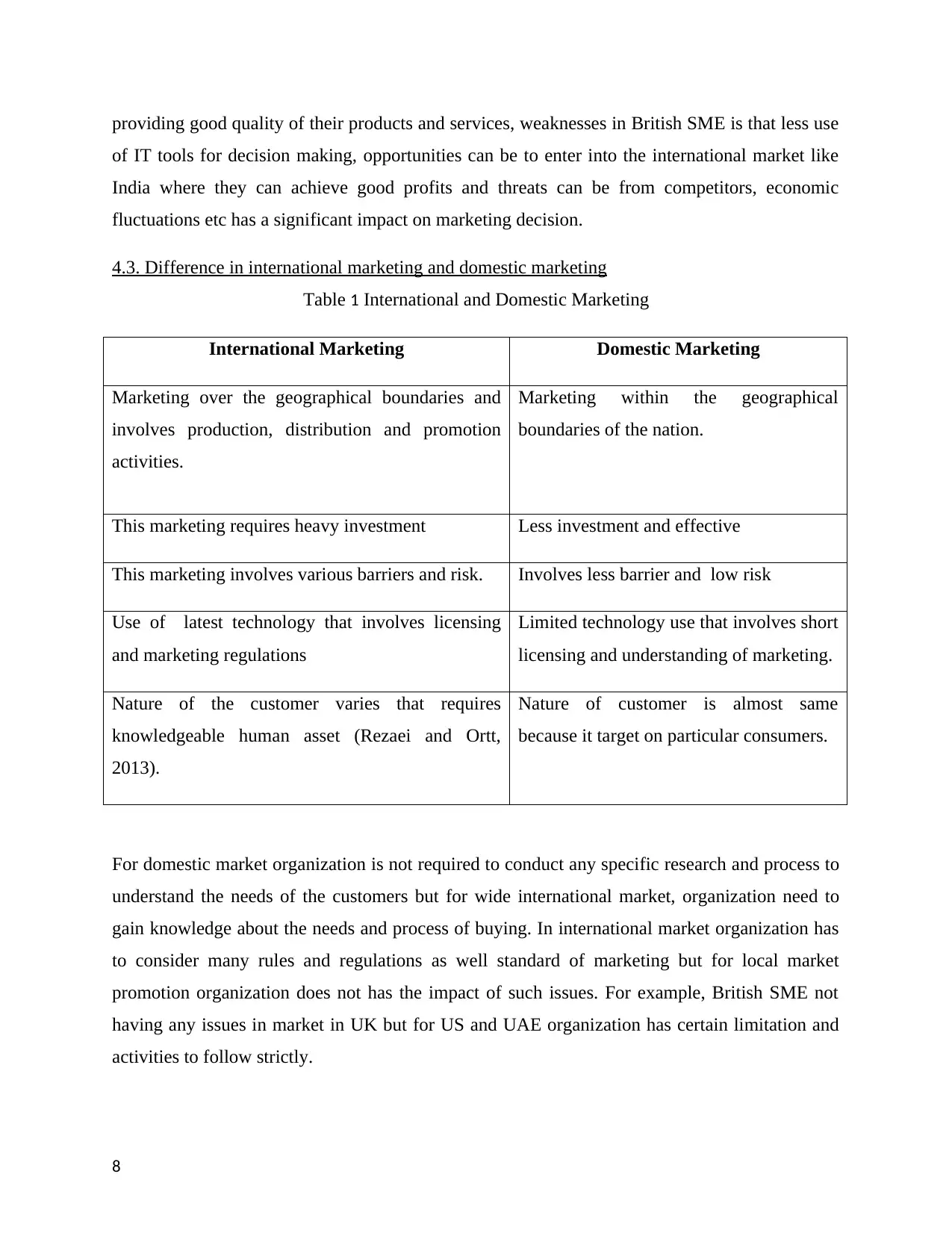
providing good quality of their products and services, weaknesses in British SME is that less use
of IT tools for decision making, opportunities can be to enter into the international market like
India where they can achieve good profits and threats can be from competitors, economic
fluctuations etc has a significant impact on marketing decision.
4.3. Difference in international marketing and domestic marketing
Table 1 International and Domestic Marketing
International Marketing Domestic Marketing
Marketing over the geographical boundaries and
involves production, distribution and promotion
activities.
Marketing within the geographical
boundaries of the nation.
This marketing requires heavy investment Less investment and effective
This marketing involves various barriers and risk. Involves less barrier and low risk
Use of latest technology that involves licensing
and marketing regulations
Limited technology use that involves short
licensing and understanding of marketing.
Nature of the customer varies that requires
knowledgeable human asset (Rezaei and Ortt,
2013).
Nature of customer is almost same
because it target on particular consumers.
For domestic market organization is not required to conduct any specific research and process to
understand the needs of the customers but for wide international market, organization need to
gain knowledge about the needs and process of buying. In international market organization has
to consider many rules and regulations as well standard of marketing but for local market
promotion organization does not has the impact of such issues. For example, British SME not
having any issues in market in UK but for US and UAE organization has certain limitation and
activities to follow strictly.
8
of IT tools for decision making, opportunities can be to enter into the international market like
India where they can achieve good profits and threats can be from competitors, economic
fluctuations etc has a significant impact on marketing decision.
4.3. Difference in international marketing and domestic marketing
Table 1 International and Domestic Marketing
International Marketing Domestic Marketing
Marketing over the geographical boundaries and
involves production, distribution and promotion
activities.
Marketing within the geographical
boundaries of the nation.
This marketing requires heavy investment Less investment and effective
This marketing involves various barriers and risk. Involves less barrier and low risk
Use of latest technology that involves licensing
and marketing regulations
Limited technology use that involves short
licensing and understanding of marketing.
Nature of the customer varies that requires
knowledgeable human asset (Rezaei and Ortt,
2013).
Nature of customer is almost same
because it target on particular consumers.
For domestic market organization is not required to conduct any specific research and process to
understand the needs of the customers but for wide international market, organization need to
gain knowledge about the needs and process of buying. In international market organization has
to consider many rules and regulations as well standard of marketing but for local market
promotion organization does not has the impact of such issues. For example, British SME not
having any issues in market in UK but for US and UAE organization has certain limitation and
activities to follow strictly.
8
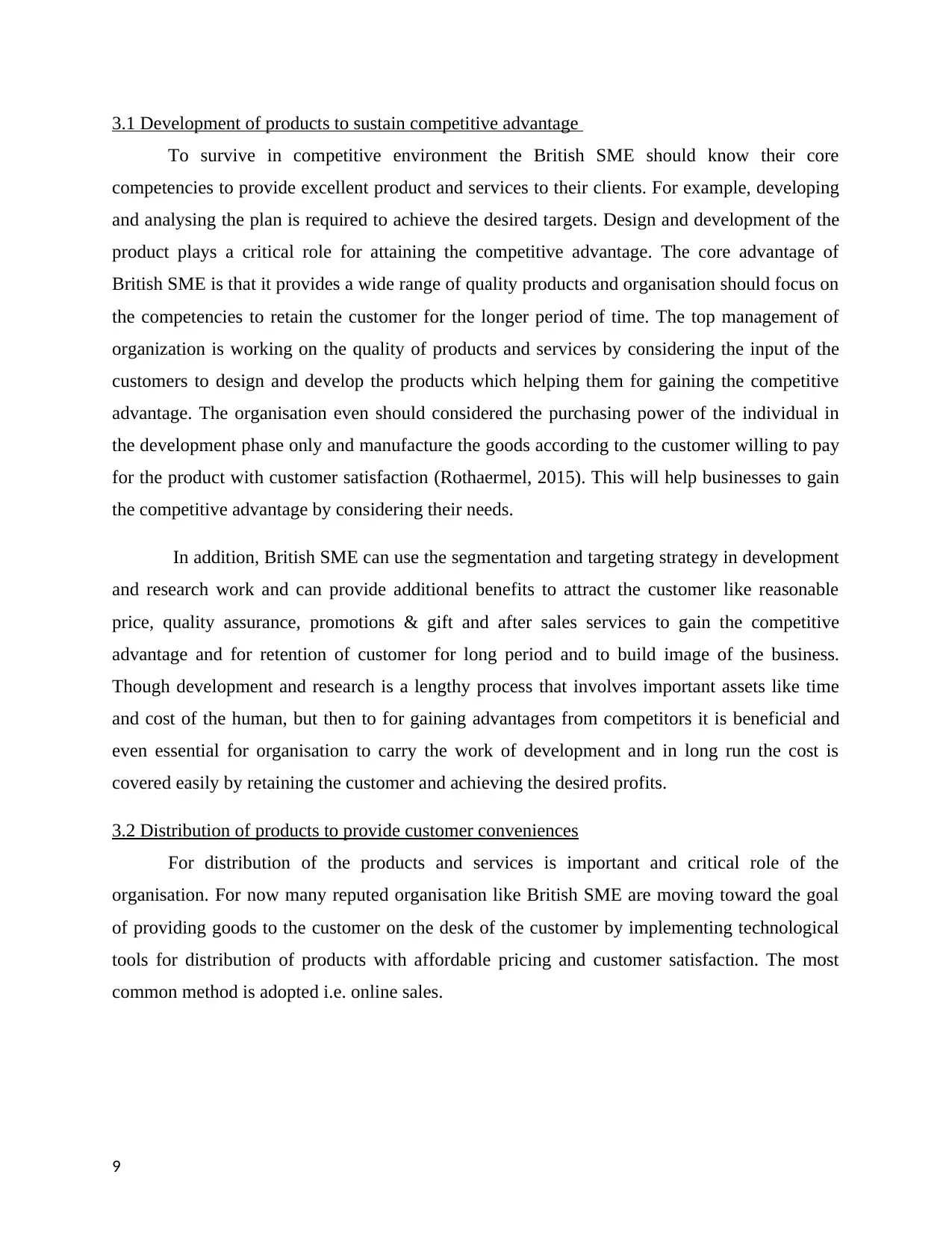
3.1 Development of products to sustain competitive advantage
To survive in competitive environment the British SME should know their core
competencies to provide excellent product and services to their clients. For example, developing
and analysing the plan is required to achieve the desired targets. Design and development of the
product plays a critical role for attaining the competitive advantage. The core advantage of
British SME is that it provides a wide range of quality products and organisation should focus on
the competencies to retain the customer for the longer period of time. The top management of
organization is working on the quality of products and services by considering the input of the
customers to design and develop the products which helping them for gaining the competitive
advantage. The organisation even should considered the purchasing power of the individual in
the development phase only and manufacture the goods according to the customer willing to pay
for the product with customer satisfaction (Rothaermel, 2015). This will help businesses to gain
the competitive advantage by considering their needs.
In addition, British SME can use the segmentation and targeting strategy in development
and research work and can provide additional benefits to attract the customer like reasonable
price, quality assurance, promotions & gift and after sales services to gain the competitive
advantage and for retention of customer for long period and to build image of the business.
Though development and research is a lengthy process that involves important assets like time
and cost of the human, but then to for gaining advantages from competitors it is beneficial and
even essential for organisation to carry the work of development and in long run the cost is
covered easily by retaining the customer and achieving the desired profits.
3.2 Distribution of products to provide customer conveniences
For distribution of the products and services is important and critical role of the
organisation. For now many reputed organisation like British SME are moving toward the goal
of providing goods to the customer on the desk of the customer by implementing technological
tools for distribution of products with affordable pricing and customer satisfaction. The most
common method is adopted i.e. online sales.
9
To survive in competitive environment the British SME should know their core
competencies to provide excellent product and services to their clients. For example, developing
and analysing the plan is required to achieve the desired targets. Design and development of the
product plays a critical role for attaining the competitive advantage. The core advantage of
British SME is that it provides a wide range of quality products and organisation should focus on
the competencies to retain the customer for the longer period of time. The top management of
organization is working on the quality of products and services by considering the input of the
customers to design and develop the products which helping them for gaining the competitive
advantage. The organisation even should considered the purchasing power of the individual in
the development phase only and manufacture the goods according to the customer willing to pay
for the product with customer satisfaction (Rothaermel, 2015). This will help businesses to gain
the competitive advantage by considering their needs.
In addition, British SME can use the segmentation and targeting strategy in development
and research work and can provide additional benefits to attract the customer like reasonable
price, quality assurance, promotions & gift and after sales services to gain the competitive
advantage and for retention of customer for long period and to build image of the business.
Though development and research is a lengthy process that involves important assets like time
and cost of the human, but then to for gaining advantages from competitors it is beneficial and
even essential for organisation to carry the work of development and in long run the cost is
covered easily by retaining the customer and achieving the desired profits.
3.2 Distribution of products to provide customer conveniences
For distribution of the products and services is important and critical role of the
organisation. For now many reputed organisation like British SME are moving toward the goal
of providing goods to the customer on the desk of the customer by implementing technological
tools for distribution of products with affordable pricing and customer satisfaction. The most
common method is adopted i.e. online sales.
9
⊘ This is a preview!⊘
Do you want full access?
Subscribe today to unlock all pages.

Trusted by 1+ million students worldwide
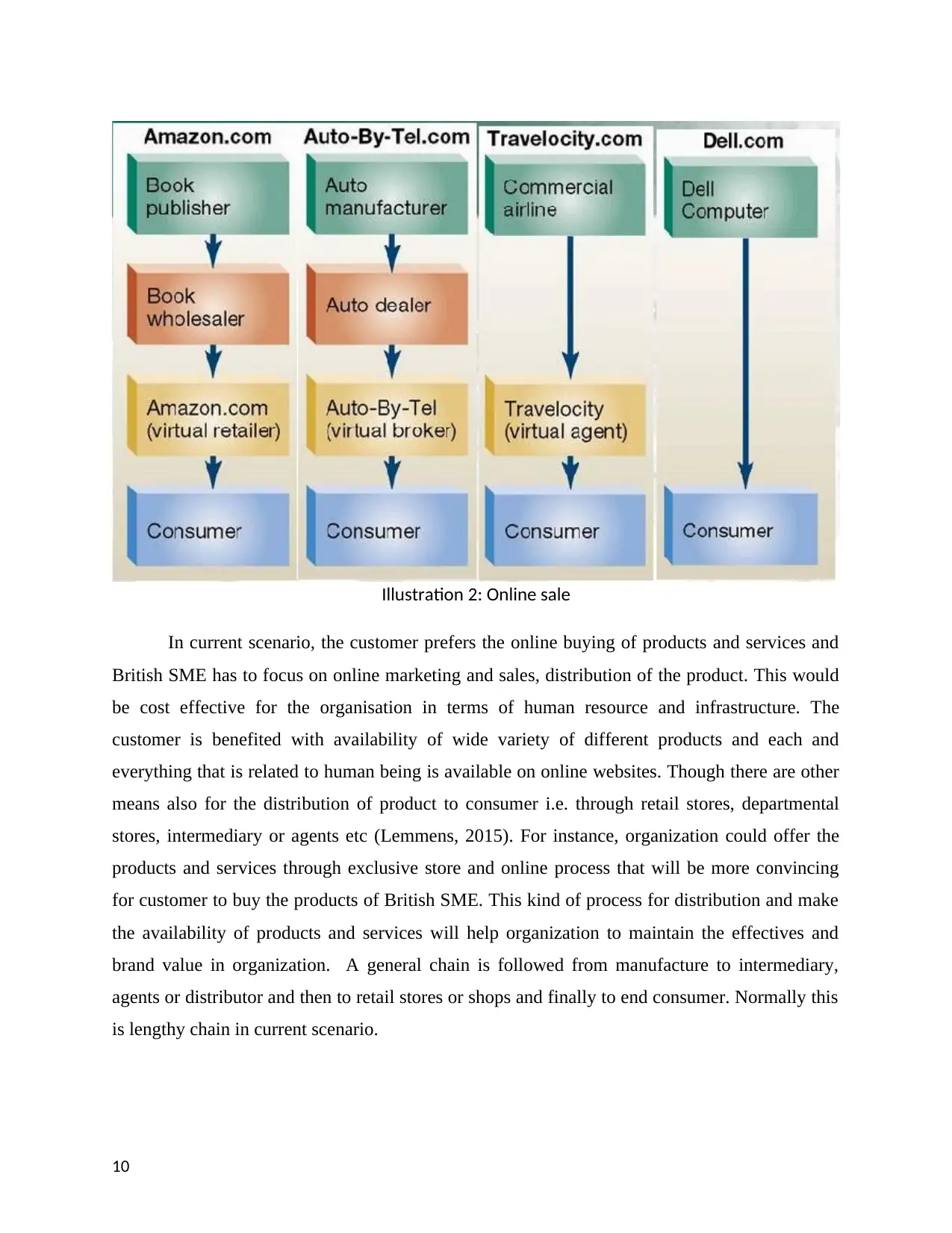
Illustration 2: Online sale
In current scenario, the customer prefers the online buying of products and services and
British SME has to focus on online marketing and sales, distribution of the product. This would
be cost effective for the organisation in terms of human resource and infrastructure. The
customer is benefited with availability of wide variety of different products and each and
everything that is related to human being is available on online websites. Though there are other
means also for the distribution of product to consumer i.e. through retail stores, departmental
stores, intermediary or agents etc (Lemmens, 2015). For instance, organization could offer the
products and services through exclusive store and online process that will be more convincing
for customer to buy the products of British SME. This kind of process for distribution and make
the availability of products and services will help organization to maintain the effectives and
brand value in organization. A general chain is followed from manufacture to intermediary,
agents or distributor and then to retail stores or shops and finally to end consumer. Normally this
is lengthy chain in current scenario.
10
In current scenario, the customer prefers the online buying of products and services and
British SME has to focus on online marketing and sales, distribution of the product. This would
be cost effective for the organisation in terms of human resource and infrastructure. The
customer is benefited with availability of wide variety of different products and each and
everything that is related to human being is available on online websites. Though there are other
means also for the distribution of product to consumer i.e. through retail stores, departmental
stores, intermediary or agents etc (Lemmens, 2015). For instance, organization could offer the
products and services through exclusive store and online process that will be more convincing
for customer to buy the products of British SME. This kind of process for distribution and make
the availability of products and services will help organization to maintain the effectives and
brand value in organization. A general chain is followed from manufacture to intermediary,
agents or distributor and then to retail stores or shops and finally to end consumer. Normally this
is lengthy chain in current scenario.
10
Paraphrase This Document
Need a fresh take? Get an instant paraphrase of this document with our AI Paraphraser
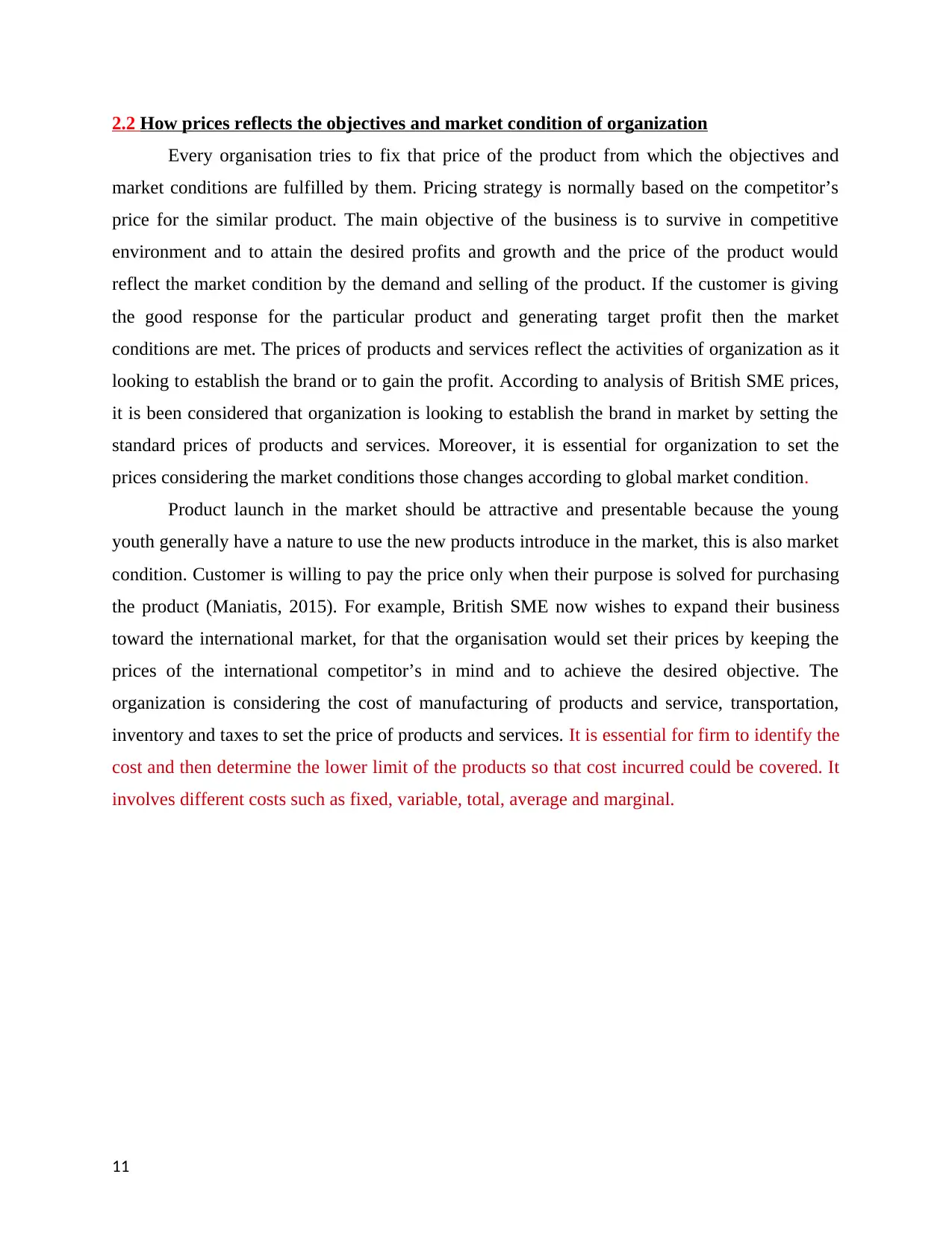
2.2 How prices reflects the objectives and market condition of organization
Every organisation tries to fix that price of the product from which the objectives and
market conditions are fulfilled by them. Pricing strategy is normally based on the competitor’s
price for the similar product. The main objective of the business is to survive in competitive
environment and to attain the desired profits and growth and the price of the product would
reflect the market condition by the demand and selling of the product. If the customer is giving
the good response for the particular product and generating target profit then the market
conditions are met. The prices of products and services reflect the activities of organization as it
looking to establish the brand or to gain the profit. According to analysis of British SME prices,
it is been considered that organization is looking to establish the brand in market by setting the
standard prices of products and services. Moreover, it is essential for organization to set the
prices considering the market conditions those changes according to global market condition.
Product launch in the market should be attractive and presentable because the young
youth generally have a nature to use the new products introduce in the market, this is also market
condition. Customer is willing to pay the price only when their purpose is solved for purchasing
the product (Maniatis, 2015). For example, British SME now wishes to expand their business
toward the international market, for that the organisation would set their prices by keeping the
prices of the international competitor’s in mind and to achieve the desired objective. The
organization is considering the cost of manufacturing of products and service, transportation,
inventory and taxes to set the price of products and services. It is essential for firm to identify the
cost and then determine the lower limit of the products so that cost incurred could be covered. It
involves different costs such as fixed, variable, total, average and marginal.
11
Every organisation tries to fix that price of the product from which the objectives and
market conditions are fulfilled by them. Pricing strategy is normally based on the competitor’s
price for the similar product. The main objective of the business is to survive in competitive
environment and to attain the desired profits and growth and the price of the product would
reflect the market condition by the demand and selling of the product. If the customer is giving
the good response for the particular product and generating target profit then the market
conditions are met. The prices of products and services reflect the activities of organization as it
looking to establish the brand or to gain the profit. According to analysis of British SME prices,
it is been considered that organization is looking to establish the brand in market by setting the
standard prices of products and services. Moreover, it is essential for organization to set the
prices considering the market conditions those changes according to global market condition.
Product launch in the market should be attractive and presentable because the young
youth generally have a nature to use the new products introduce in the market, this is also market
condition. Customer is willing to pay the price only when their purpose is solved for purchasing
the product (Maniatis, 2015). For example, British SME now wishes to expand their business
toward the international market, for that the organisation would set their prices by keeping the
prices of the international competitor’s in mind and to achieve the desired objective. The
organization is considering the cost of manufacturing of products and service, transportation,
inventory and taxes to set the price of products and services. It is essential for firm to identify the
cost and then determine the lower limit of the products so that cost incurred could be covered. It
involves different costs such as fixed, variable, total, average and marginal.
11
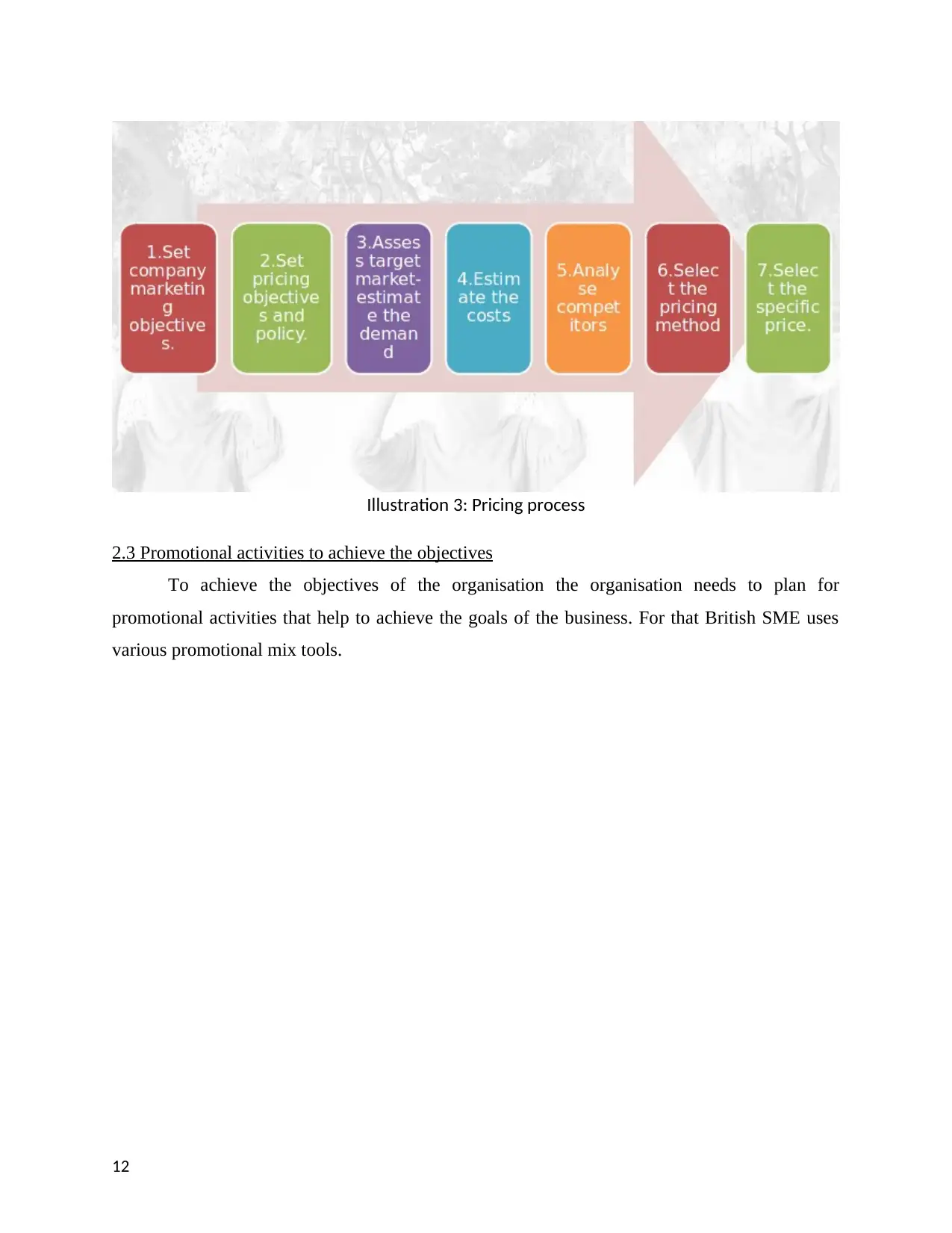
Illustration 3: Pricing process
2.3 Promotional activities to achieve the objectives
To achieve the objectives of the organisation the organisation needs to plan for
promotional activities that help to achieve the goals of the business. For that British SME uses
various promotional mix tools.
12
2.3 Promotional activities to achieve the objectives
To achieve the objectives of the organisation the organisation needs to plan for
promotional activities that help to achieve the goals of the business. For that British SME uses
various promotional mix tools.
12
⊘ This is a preview!⊘
Do you want full access?
Subscribe today to unlock all pages.

Trusted by 1+ million students worldwide
1 out of 22
Related Documents
Your All-in-One AI-Powered Toolkit for Academic Success.
+13062052269
info@desklib.com
Available 24*7 on WhatsApp / Email
![[object Object]](/_next/static/media/star-bottom.7253800d.svg)
Unlock your academic potential
Copyright © 2020–2025 A2Z Services. All Rights Reserved. Developed and managed by ZUCOL.


![Marketing Principles: A Case Study on ALDI (UK) - [Course Code]](/_next/image/?url=https%3A%2F%2Fdesklib.com%2Fmedia%2Fimages%2Ftw%2Fb396d4bd6b394a72841d1ce45968ac0c.jpg&w=256&q=75)


